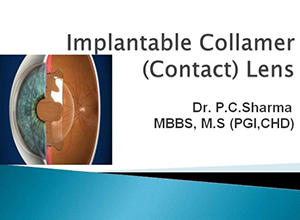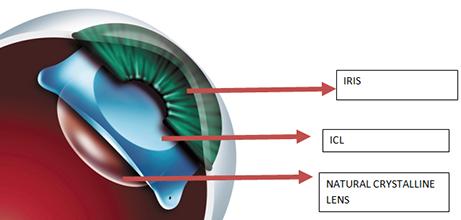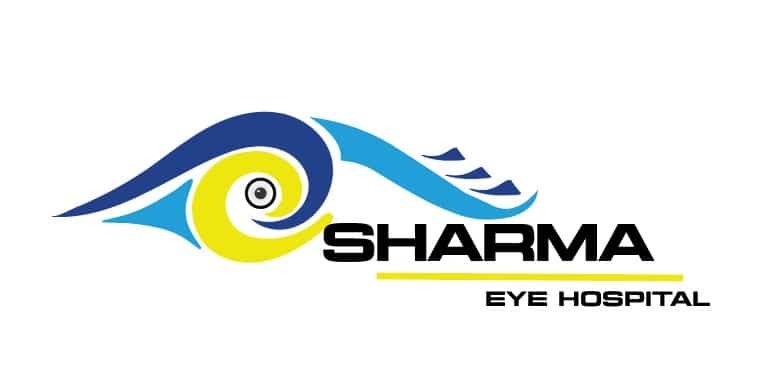ICL Informational Videos
Implantable collamer lenses (ICLs), also known as phakic IOLs, correct vision in much the same way that external contact lenses do, except ICLs are surgically placed inside the eye, where they permanently improve vision. Phakic, from the Greek word “phakos,” for lens, refers to artificial lenses that operate in conjunction with the patient’s natural lenses.
While ICLs function in almost exactly the same way as contact lenses that sit atop the eye, they are also similar to intraocular lenses (IOLs), which are used during cataract surgery to replace the eye’s natural lens after it has been fragmented and removed. However, during ICL surgery, the natural lens is kept in the eye and works with the implanted lens to correct vision.
ICLs are inserted through tiny incisions in the cornea and placed behind or in front of the iris (The colored part of the eye) and in front of the natural lens. These thin, pliable lenses can serve as an alternative to laser eye surgery procedures such as LASIK and are often used to correct conditions that laser procedures may be unable to correct, such as extreme myopia. The ICL procedure produces little to no discomfort for the patient and has a 95 percent average success rate.
EVO VISIAN ICL (IMPLANTABLE COLLAMER LENS)
1. About EVO ICL :
EVO,also known as the Implantable Collamer® Lens, is a type of refractive procedure which corrects common vision problems, like nearsightedness, astigmatism, and farsightedness. It can help you achieve sharp, clear vision that provides you exceptional quality of vision.
EVO Visian ICL is a soft, flexible lens that is positioned in your eye between the iris (colored part of the eye) and your natural lens.
Imagine your life with visual freedom.
It can be described as additive vision correction. Unlike other procedures, the EVO procedure does not remove the corneal tissue but works in harmony with your natural eyes.
Wide Range of Treatment Contact lenses and glasses can be a hassle and limiting. EVO ICL can treat a wide range of prescriptions, from -3 to -20 diopters.
filler imageEVO ICL image
EVO ICL image
2. Material :
Made From Collamer®, a Collagen Co-Polymer Proprietary to STAAR Surgical, Collamer® is biocompatible, stable and flexible, enabling minimally invasive insertion and encouraging harmony with your natural eye.
EVOs are easy to implant in the eye because of the soft and flexible structure. You won’t even know it’s there other than the fact that you have great vision.
3. Requirements :
EVO Candidates
Are between 21 and 60 years old.
Are near-sighted with mild to severe myopia (-0.5D to -20D).
Are farsighted with mild to severe hyperopia (+0.5D to +10.0D)
Have astigmatism between 0.5 and 6.0 D
Have not had a change in prescription of more than .5D in a year.
Are looking for a procedure that doesn’t create dry eye syndrome.
4. Procedure :
The EVO procedure is minimally invasive, and the lens is implanted through a small opening allowing for a quick procedure and recovery time.
With over 1,000,000 lenses implanted worldwide and 20+ years of premium ICL performance, EVO is quickly becoming a vision correction procedure of choice for many people around the world.
5. Why People Choose EVO Visian ICL? :
Sharp, Clear Vision.
Superb Results. 99.4% of patients would have ICL procedure again.
Excellent Night Vision. Many patients achieve excellent night vision.
Quick Results. Often, patients can achieve improved vision immediately following procedure.
Great for Thin Corneas. Many patients are excluded from other forms of vision correction because of thin corneas, but not with EVO Visian ICL
Great for High Nearsightedness. EVO can correct and reduce nearsightedness (myopia) of up to 20D.
Does not induce dry eye syndrome.
In harmony with your natural eyes.
EVO ICL imageEVO ICL imageEVO ICL image
EVO ICL imageEVO ICL imageEVO ICL image
EVO ICL imageEVO ICL image
Frequently asked questions:
1. Exactly where is the EVO Visian ICL placed in the eye?
— EVO Visian ICL is placed behind the iris and in front of the eye’s natural lens so it’s undetectable to any observers.
2. What is the history of the ICL?
— Over the past 20 years, ICLs have been implanted in over 1,000,000 eyes worldwide.
3. Why is Collamer such a great material for the eye?
— The Collamer lens is soft, pliable, biocompatible and offers UV protection.
4. Are patients happy with the EVO Visian ICL?
— Of patients having the EVO Visian ICL procedure, 99.4% would choose to have the EVO Visian ICL procedure again.
5. Can the EVO Visian ICL be removed in the future if my prescription changes?
— Yes! The EVO Visian ICL offers treatment flexibility. If your vision changes dramatically, the lens can be removed.
6. How long can EVO Visian ICL stay in the eye?
— The EVO Visian ICL is designed to stay in your eye permanently but can be removed to keep pace with advancing technology and your future needs.
7. Does the procedure remove tissue from my eye?
— No, the EVO Visian ICL is inserted gently in the eye with no removal of corneal tissue.
8. Can the EVO Visian ICL dry out or get dirty like a contact lens?
— The EVO Visian ICL avoids such problems experienced with traditional contact lenses. It is designed to remain in place inside the eye, without maintenance. A routine, annual visit with an eye doctor is recommended to make sure everything remains safe and effective.
9. How the EVO Visian ICL corrects Nearsightedness and Astigmatism?
— EVO Visian ICL functions to focus light properly back onto the retina in a similar way glasses and contact lenses do. The EVO Visian ICL is placed into a space of the eye directly behind the iris (the colored part of the eye) and in front of the natural lens. In this position, the EVO Visian ICL functions to focus light properly onto the retina helping create clear distance vision.
Important safety information for Evo Visian ICL:
Before considering EVO Visian ICL surgery you should have a complete eye examination and talk with your eye care professional about EVO Visian ICL surgery, especially the potential benefits, risks and complications. You should discuss the time needed for healing after surgery.



